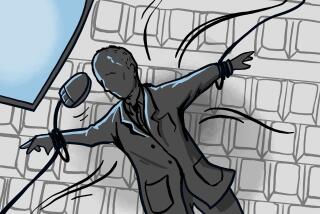THEATER REVIEW : ‘Anatomy’: Good for What Ails You
- Share via
Spalding Gray’s a sick man.
Lucky us.
In “Gray’s Anatomy,” his funniest and most profound monologue since “Swimming to Cambodia,” the middle-aged crazies take possession of America’s first neurotic and No. 1 storyteller.
This self-described WASP Woody Allen has hit 50 and his body is slipping into “the Bermuda Triangle of Health.” Gray’s first sign of physical decay is a “macula pucker”--a growth on the retina of his left eye--and his search for a miraculous cure sends Gray on increasingly bizarre pilgrimages, from New Jersey’s New Age nutritionists to the Philippines’ psychic surgeons. His trips become a howl of high anxiety and hilarity.
But they’re trips without slides, maps or props. This tour guide’s exquisitely refined actor’s voice takes us there. Wearing a plaid flannel shirt and jeans, Gray meanders onto the stage and sits at a simple table. His only props are a notebook and a glass of water. He cozily leans into a microphone, like a friend in a bar about to confess a secret. We can barely hear his first words: “I think it all began when. . . .”
Thank the entertainment gods that Gray wasn’t diagnosed with Alzheimer’s. Gray’s minimalist stage art depends on remembrances of things past. He’s a Proustian camera and his memory works as film. He calls this technique “poetic journalism,” a mixture of autobiography and sociology and comic improvisations, but his 14th monologue is a creative breakthrough from previous stories. It goes beyond the eccentric confines of “Monster in a Box,” which explored writer’s block, or the Hollywood-insider observations of “Swimming to Cambodia.”
“Gray’s Anatomy” is about the Big Fear: Death. How do we live with it? Do we fight it? Do we accept it? Is there a faith that a cynic like Gray can embrace? For the first time, Gray’s obsessions aren’t a freak show. We share his anatomy so we identify with his sadness. “Gray’s Anatomy” is his most accessible and his most romantic. It’s also the first one with a truly happy ending.
But that ending isn’t a Hollywood happily-ever-after fade out. Gray’s search for alternative therapies begins in an ophthalmologist (rhymes with monologuist) office, where he’s encouraged to get “a little macula scraping.”
Minor surgery? Gray is off-and-running for a cure, a cause, a clinic--anything to avoid that eye-scrape. Maybe the ailment surfaced because he writes in the first-person: “ . . . too much I, I, I, I, I!” Maybe it was caused by his novel “Impossible Vacation,” with the detached examination of his mother’s suicide?
Gray grew up in a Christian Science home, where “correct thinking” offered the only cure. His poignant memories of childhood underscore the desperation. His therapist, “an existential realist and graduate of Auschwitz,” offers little consolation: “All things are contingent and there is also chaos.” So Gray pursues radical nutritionists, a Native American sorceress, and “the Elvis Presley of psychic surgeons.”
He tries everything. Raw vegetables. Gestalt screams. Gives up alcohol and amino acids. Takes out a personal ad: “Let’s share puckers.” He even returns, briefly, to Christian Science prayer.
There is a lull when we assume that the piece’s climax is the eye operation. But Gray is a trickster, and the goal of his “Anatomy” is not physical but spiritual healing. “I believe in magic,” confesses the life-long ironist and cynic. “I believe that there has to be real magic if there are tricks in the world. And what is a trick if not an imitation of real magic?”
Gray’s a magician of words whose enchanted “Anatomy” is the best cure for what ails him--and us. See it.
* “Gray’s Anatomy,” Wadsworth Theater, Veterans Administration grounds, West Los Angeles. Tonight and Saturday at 8. (310) 825-2101. Campbell Hall, University of California Santa Barbara, April 27-28, 8 p.m.; Irvine Barclay Theatre, May 1, 3 p.m. Running time: 2 hours.
More to Read
The biggest entertainment stories
Get our big stories about Hollywood, film, television, music, arts, culture and more right in your inbox as soon as they publish.
You may occasionally receive promotional content from the Los Angeles Times.










